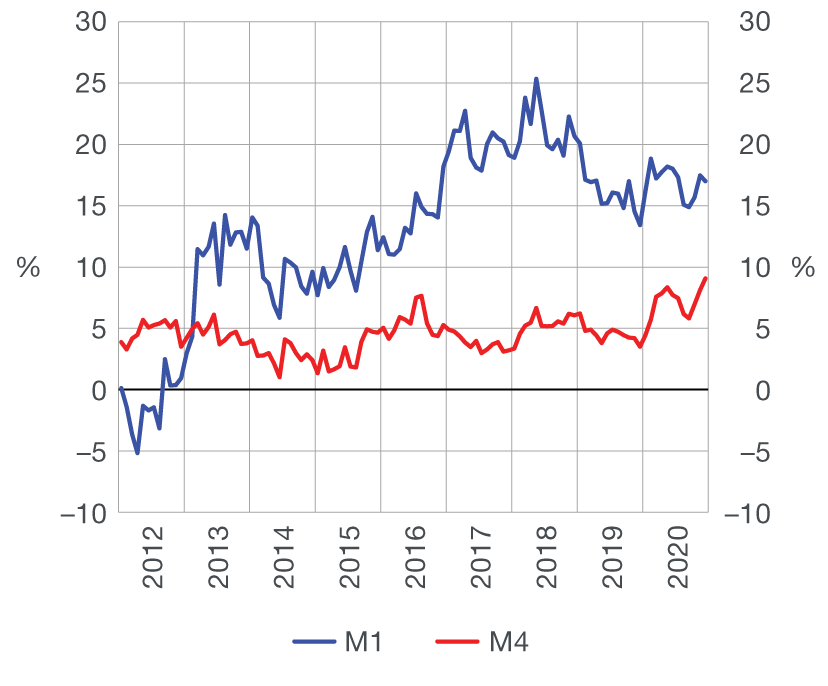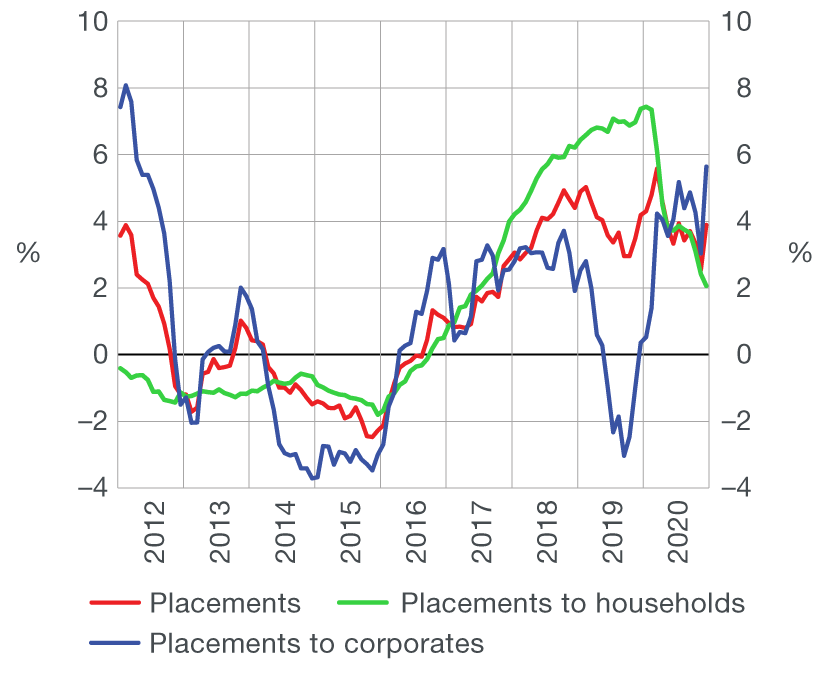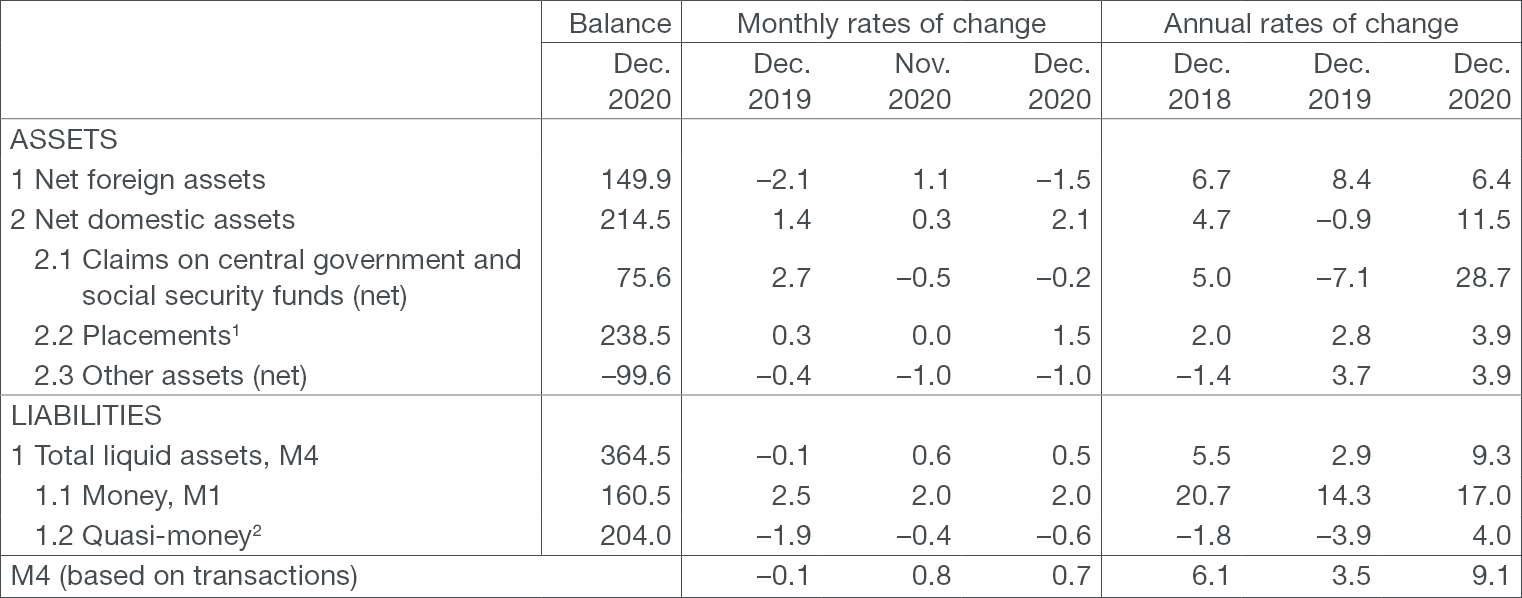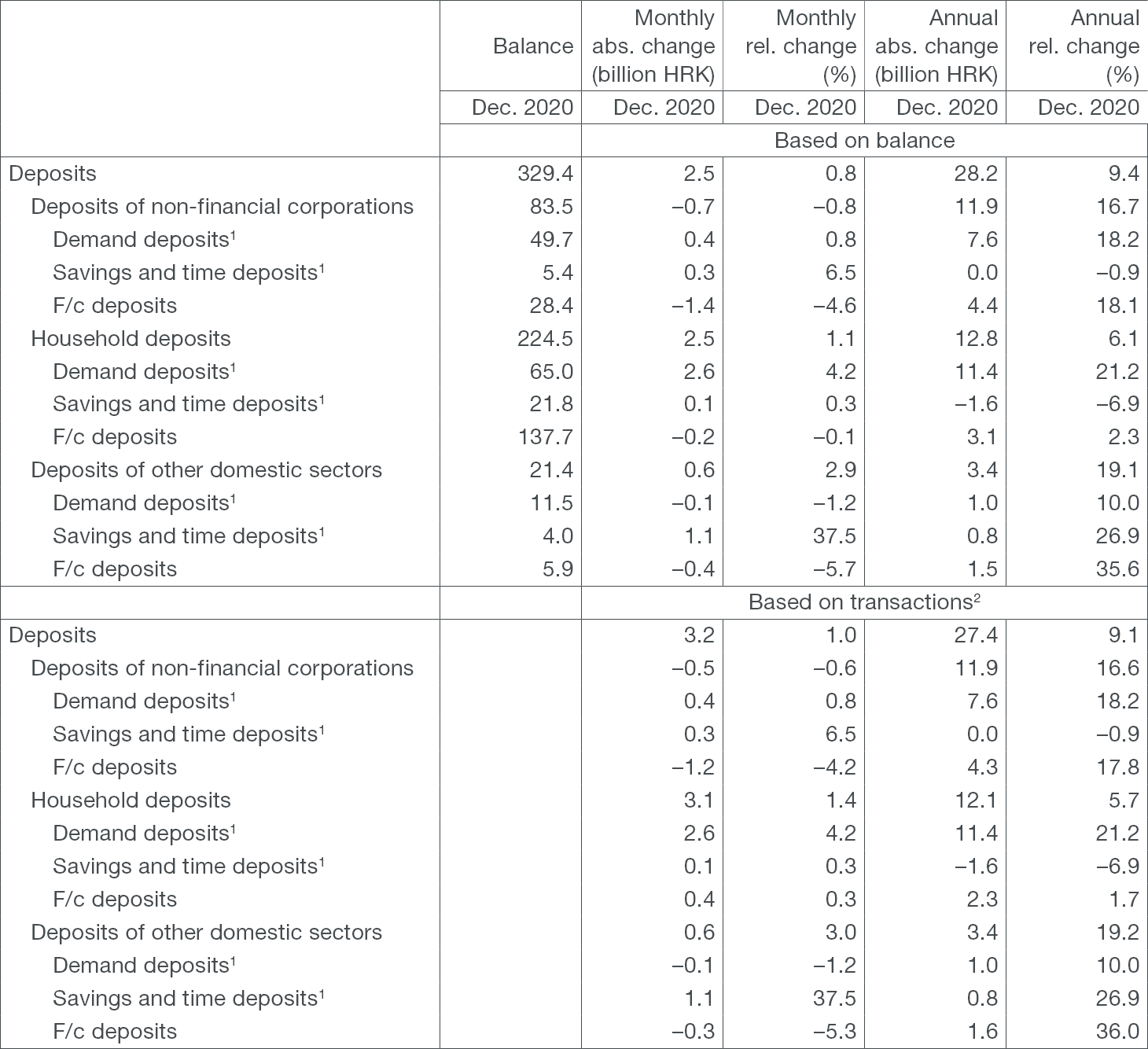From August 2023 the comments on statistics, a short description of selected, recently issued statistical data in the area of monetary statistics and the non-residents sector statistics, are no longer published. They are replaced by Statistical releases.
Comments on monetary developments for December 2020
The growth of total liquid assets (M4) accelerated strongly in 2020, primarily due to the strong increase in net claims of monetary institutions on the central government. The structure of monetary growth also changed from the previous years due to stronger lending to the government.
The growth of total placements of monetary institutions to domestic sectors (excluding the central government) slowed down slightly in 2020 primarily due to slower growth of household placements, while the growth of placements to financial and non-financial corporations accelerated. There was not much interest of households for general-purpose cash loans in 2020, while housing loans to households increased thanks to the housing loans subsidy programme.
Total liquid assets (M4[1]) increased in December 2020 by HRK 2.7bn (0.7%, based on transactions), totalling HRK 364.5bn at the end of the month (Table 1). The monthly increase in this broadest monetary aggregate was aided by the growth in net domestic assets (NDA), which was partly offset by the decrease in net foreign assets (NFA) of the monetary system under the influence of the seasonal increase in the deficit of foreign trade of goods and services. The fall in the NFA of the monetary system was a result of the decrease of the NFA of credit institutions, while the NFA of the CNB strongly increased mainly due to the inflow of funds from EU funds which resulted in the increase of the government's foreign currency deposits with the CNB as well as in the sale of foreign currency to the CNB, and due to inflows to foreign currency deposits of credit institutions with the CNB (these deposits representing bank assets in the TARGET2 system) and the CNB's foreign exchange intervention.
In comparison to 2019, the growth of total liquid assets accelerated strongly in 2020, from 3.5% to 9.1% (Figure 1). The structure of monetary growth also changed noticeably, with the contribution of NDA growth increasing and the significance of NFA decreasing. Faster growth in net domestic assets was primarily spurred by the strong increase in net claims on the central government due to the CNB's repurchase of government securities in the secondary market. Broken down by the components of M4, the annual growth in money (M1[2]) accelerated from 13.4% in 2019 to 17.0% in 2020 primarily due to stronger growth in demand deposits which reached 18.9% in 2020 (14.4% in 2019). After three years of uninterrupted decline, quasi-money started registering positive rates of change in 2020, its growth accelerating from –2.4% to 3.6% (transaction-based) primarily due to the increase in foreign currency deposits (Table 3).
| Figure 1 Monetary aggregates annual rates of change based on transactions |
Figure 2 Placements annual rates of change based on transactions |
 |
 |
| Source: CNB. |
Total placements of monetary institutions to domestic sectors (excluding the central government) stood at HRK 238.5bn at the end of December 2020, up HRK4.1bn (1.8% based on transactions) from the end of November. Loans, as the largest component, totalled HRK 232.6bn, up HRK 4.0bn or 1.7% (based on transactions) from November (Table 2). More than a half of the monthly growth was accounted for by corporate loans, i.e. one large transaction registered in December. Loans to households continued to grow during the month in question (HRK 0.2bn), with housing loans increasing by HRK 1.0bn and thus reflecting the effects of the government's housing loans subsidy programme, while general-purpose cash loans continued to reduce. On an annual level, the growth of total placements slowed down slightly, to 3.9% in 2020, from 4.2% in 2019 (based on transactions) (Figure 2). Broken down by sector, corporate loans registered the greatest growth (HRK 4.9bn), which was also reflected in the acceleration of the annual growth from 1.8% in 2019 to 6.0% in 2020 (based on transactions). The growth of household loans slowed down significantly in 2020, so, after having growth by 7.4% in 2019, last year household loans went up by only HRK 2.7bn or 2.1%. The rise in housing loans was especially strong (HRK 4.3bn), with their growth even accelerating in 2020 under the influence of government subsidies. On the other side, general-propose loans decreased by HRK 0.7bn or 1.4% from the end of the last year due to uncertainties surrounding the crisis caused by the COVID-19 pandemic after having grown by 11.5% in 2019.
Table 1 Summary consolidated balance sheet of monetary institutions
in billion HRK and %

1 The sum total of asset items 2.2 to 2.8 of Bulletin Table B1: Consolidated balance sheet of monetary financial institutions.
2 The sum total of liability items 2 to 5 of Bulletin Table B1: Consolidated balance sheet of monetary financial institutions.
Source: CNB.
Table 2 Loans (except the central government) and main components
in billion HRK and %

1 In addition to loans to households and corporates, they also include loans to the local government and other financial institutions.
2 The transactions show changes that exclude the effects of exchange rate changes, securities price adjustments, reclassification and write-off of placements, including the sale of placements in the amount of their value adjustment.
Source: CNB.
Table 3 Deposits (except the central government) and main components
in billion HRK and %

1 Includes only kuna sources of funds of credit institutions.
2 The transactions show changes that exclude the effects of exchange rate changes, securities price adjustments, reclassification and write-off of placements, including the sale of placements in the amount of their value adjustment.
Source: CNB.
For detailed information on monetary statistics as at December 2020, see:
Central bank (CNB)
Other monetary financial institutions
